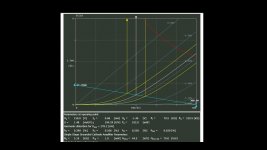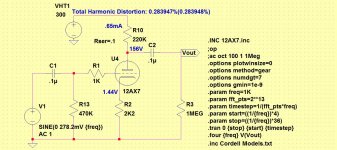Not sure if anyone is following this thread anymore, but I just figured out how to use it today and am having a blast going thru my Yaqin MS-12B looking at the data this program displays and it is awesome, I love it, thank you for creating gsmok.
I don't know how difficult it is to add a tube, but would kindly ask next time you are doing so, could you please include 12AY7A or 6072A?
Thank you
I don't know how difficult it is to add a tube, but would kindly ask next time you are doing so, could you please include 12AY7A or 6072A?
Thank you
Dziękuję Ci gsmok!
Do you think it would be possible to add an option to let the system automatically sweep different configurations to find specific parameters? EG lowest distortion, or specific ratios between different harmonics? That would be really great to find new ways of using the same triodes.
I've done it manually but an automatic option would be even better.
Do you think it would be possible to add an option to let the system automatically sweep different configurations to find specific parameters? EG lowest distortion, or specific ratios between different harmonics? That would be really great to find new ways of using the same triodes.
I've done it manually but an automatic option would be even better.
It is possible. However, this is an optimization problem that can be difficult to resolve mathematically. For example, harmonic distortions may have local minima and finding a global minimum cannot be done by traditional analytical methods.
I don't know if I have already written about it, but I used to play with a similar problem while writing a program that, using a random search algorithm, found tube parameters based on measuring points of anode characteristics.
After optimization (pressing the [optimize] key repeatedly) and recognizing that the characteristics match the measured points, you can read the tube parameters and generate SPICE tube models.
Here is a link to the program with sample data that can be imported.
Tube Model Optimizer v.1.0 (2015-04-28 www.trioda.com)
The randomness of the process of finding optimal parameters of analyzed tube can be observed by restarting the program. The results are a little different each time. From time to tine it happens that the program is unable to find the optimal parameters of the model.
I don't know if I have already written about it, but I used to play with a similar problem while writing a program that, using a random search algorithm, found tube parameters based on measuring points of anode characteristics.
After optimization (pressing the [optimize] key repeatedly) and recognizing that the characteristics match the measured points, you can read the tube parameters and generate SPICE tube models.
Here is a link to the program with sample data that can be imported.
Tube Model Optimizer v.1.0 (2015-04-28 www.trioda.com)
The randomness of the process of finding optimal parameters of analyzed tube can be observed by restarting the program. The results are a little different each time. From time to tine it happens that the program is unable to find the optimal parameters of the model.
@gsmok
Some of the values like "MU" are readily observable from the datasheets around a particular operating point, and some, like "EX" have to be bounded. With Excel "Solver" I initially fix a value for MU and set a range of reasonable values for EX, the rest falls out and almost always converges.
I use two "error terms" and find the minimum of either sum percent squared errors, or sum log squashed error.
I applaud you for your work!!!
Some of the values like "MU" are readily observable from the datasheets around a particular operating point, and some, like "EX" have to be bounded. With Excel "Solver" I initially fix a value for MU and set a range of reasonable values for EX, the rest falls out and almost always converges.
I use two "error terms" and find the minimum of either sum percent squared errors, or sum log squashed error.
I applaud you for your work!!!
Hi,
can you add 3A5 and 4P1L (triode connected) to the list?
3A5
3A5 DHT – Bartola(R) Valves
3A5 (sections in parallel)
3A5 DHT (Continued) – Bartola(R) Valves
4P1L (triode connected)
4P1L SPICE model updated – Bartola(R) Valves
Thank you
can you add 3A5 and 4P1L (triode connected) to the list?
3A5
3A5 DHT – Bartola(R) Valves
3A5 (sections in parallel)
3A5 DHT (Continued) – Bartola(R) Valves
4P1L (triode connected)
4P1L SPICE model updated – Bartola(R) Valves
Thank you
I found that sometimes the distortion values calculated are not updated except if you follow a certain procedure which is set the bias and change the Vinp(even if you do not want to change it, just move ot and bring it back to the original value). In that case values are correct, otherwise old valiies sometime stay...could you erase that bug ?
completed load line chart to (microsoft) print pdf
Hi gsmok, just getting started in tubes again after ~60 years.. You have created a wonderful tool that lets me explore 'what if' situations, and which shows cause and effect. Thanks very much, great job.
Currently engaged in trying to configure stages of Compactron tube 6AF11, which has two triodes (~12AT7 and perhaps 6S3P-EV?) and a pentode (~ECL80).
When trying to print a completed chart with Microsoft Print (to pdf), the print always messes up the variables (curves, load-line and pp envelope are all shifted to the right, while frame remains in place). Have tried this in google chrome and firefox, with same result. Any suggestions?
Hi gsmok, just getting started in tubes again after ~60 years.. You have created a wonderful tool that lets me explore 'what if' situations, and which shows cause and effect. Thanks very much, great job.
Currently engaged in trying to configure stages of Compactron tube 6AF11, which has two triodes (~12AT7 and perhaps 6S3P-EV?) and a pentode (~ECL80).
When trying to print a completed chart with Microsoft Print (to pdf), the print always messes up the variables (curves, load-line and pp envelope are all shifted to the right, while frame remains in place). Have tried this in google chrome and firefox, with same result. Any suggestions?
Hi, could you please raise the max voltage up to 450v for ecc81-82-83 and ecc88?
Scroll down below the graph. See the Uamax box in the blue area? Put any number you want in that box.
Here's a good explanation of the basic idea behind designing a cathode follower:
The Valve Wizard -Cathode Follower
--
The Valve Wizard -Cathode Follower
--
It is possible. However, this is an optimization problem that can be difficult to resolve mathematically. For example, harmonic distortions may have local minima and finding a global minimum cannot be done by traditional analytical methods.
I don't know if I have already written about it, but I used to play with a similar problem while writing a program that, using a random search algorithm, found tube parameters based on measuring points of anode characteristics.
After optimization (pressing the [optimize] key repeatedly) and recognizing that the characteristics match the measured points, you can read the tube parameters and generate SPICE tube models.
Here is a link to the program with sample data that can be imported.
Tube Model Optimizer v.1.0 (2015-04-28 [url]www.trioda.com)[/url]
The randomness of the process of finding optimal parameters of analyzed tube can be observed by restarting the program. The results are a little different each time. From time to tine it happens that the program is unable to find the optimal parameters of the model.
Could always code up a DWave quantum annealer version then use quantum tunnelling to find the lowest power level
Only three feature requests:
* 6AS7/6080
* Second Class-B line for AB
* Mirror for push-pull configuration
- Home
- Amplifiers
- Tubes / Valves
- Triode/Pentode Loadline Calculator


